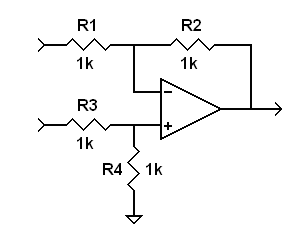| Vocademy |
Differential Amplifier
The differential amplifier, like the inverting amplifier, has a voltage divider on the feedback loop. However, it also has a voltage divider on the non-inverting input.
 |
| An op-amp differential amplifier |
If all four resistors have the same value, the amplifier will have a gain of 1 (unity gain). In that case, the output voltage will be the difference between the two input voltages. The differential amplifier is the opposite of the summing amplifier. It subtracts the voltage at the R3 input from the voltage at the R1 input[1].
 |
| An op-amp differential amplifier subtracts the upper input from the lower input. |
Here is an example.
 |
|
Function example. |
The voltage at the non-inverting input will be ½ of the voltage at the lower input (see voltage dividers). In the example above, the lower input has +2 volts so the op-amp's non-inverting input will have +1 volt. The op-amp will make the output voltage whatever it takes to make the inverting input also +1 volt. R1 and R2 form a series circuit since no current can flow into the inputs of the op-amp. R1 has 3 volts across it so R2 must also have 3 volts across it. We start at +4 volts at the upper input and lose 3 volts across R1. We now have +1 volt at the inverting input and lose another 3 volts across R2. This leaves us with -2 volts at the op-amp's output. The output is equal to the voltage at the lower input minus the voltage at the upper input[2].
Now let's try some other input voltages.
 |
|
Again, the output voltage is the lower input voltage minus the upper input voltage. |
Now the voltage at the op-amp's non-inverting input +2 volts. The op-amp changes its output voltage to whatever it takes to make the inverting input also +2 volts. The upper input is +3 volts. We lose 1 volt across R1 to reach +2 volts at the inverting input; then we lose another volt across R2. This leaves us with +1 volt at the output. The output is again the lower input voltage minus the upper input voltage.
Operational Amplifiers No. 6 - Differential Amplifiers
—————————
| Vocademy |